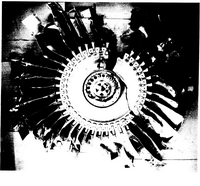
Photo from wikipedia
Abstract A configuration for a dual-duct rotating detonation aero-turbine engine (DRDATE) is proposed. With the isolator and mixer arranged upstream and downstream from the rotating detonation combustor (RDC) respectively, the… Click to show full abstract
Abstract A configuration for a dual-duct rotating detonation aero-turbine engine (DRDATE) is proposed. With the isolator and mixer arranged upstream and downstream from the rotating detonation combustor (RDC) respectively, the compatibility between turbomachinery and RDC can be realized. The conventional single annular RDC is replaced with a multi-annular RDC to expand the stable operation range of the RDC. A low-order analytical model of the rotating detonation process is presented, and comparisons between the results calculated by this model and the CFD solvers show reasonable agreement. Thereafter, a performance simulation model of the DRDATE is established, and further the variations in the overall performances with design parameters under three different flight conditions are investigated. The results demonstrate that, there exists an optimum compressor pressure ratio π opt that maximizes the specific thrust and an optimum pressure ratio π opt ′ that maximizes the thermal efficiency for the DRDATE. With an increase in the compressor and turbine polytropic efficiency and turbine inlet temperature, both π opt and π opt ′ increase monotonically. Comparisons between the DRDATE and conventional turbine engine reveal that, the former exhibits a major improvement in overall performance at low compressor pressure ratios, while the improvement decreases continuously with an increase in the pressure ratio. Moreover, as the turbine inlet temperature increases, the specific thrust improvement increases and the fuel consumption performance improvement decreases monotonically.
Journal Title: Aerospace Science and Technology
Year Published: 2019
Link to full text (if available)
Share on Social Media: Sign Up to like & get
recommendations!